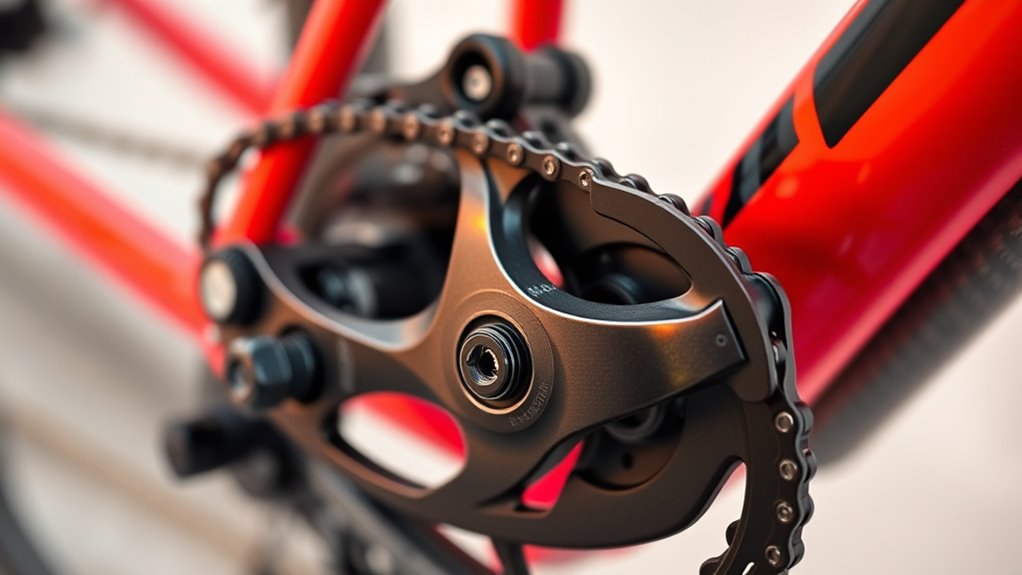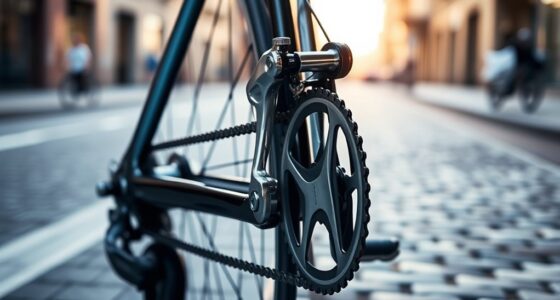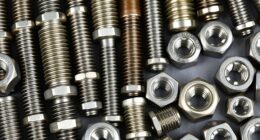Derailleurs help your bike shift gears smoothly by moving the chain between sprockets. They use cables or electronic signals to position the derailleur cage, which guides the chain across gears. To adjust, you need to check cable tension, align the derailleur hanger, and fine-tune the limit screws and barrel adjuster. Proper maintenance guarantees effortless shifting and prevents issues. Keep going to discover detailed steps to optimize your derailleur’s performance.
Key Takeaways
- Derailleurs shift the chain between sprockets by lateral movement, adjusting gear ratios for smooth pedaling.
- Proper cable tension is essential; tighten or loosen the barrel adjuster for accurate gear changes.
- Signs of malfunction include chain skipping, hesitation, or poor shifting, indicating need for adjustment or maintenance.
- Regularly clean, lubricate, and check derailleur alignment to ensure optimal performance and longevity.
- Fine-tune derailleur positioning and cable tension for precise, responsive gear shifts across all sprockets.
Understanding the Role of Derailleurs in Your Bike
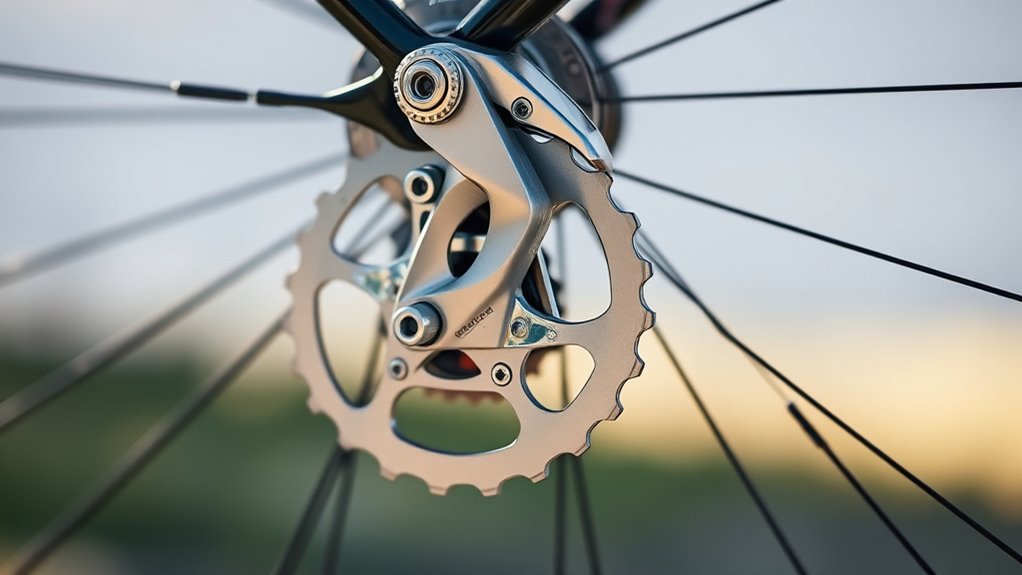
Derailleurs are vital components that keep your bike shifting smoothly across different gears. They work by moving the chain between sprockets, adjusting the gear ratio to match your riding needs. Proper derailleur alignment is essential; if it’s misaligned, shifting becomes difficult, and the chain may slip or skip. When your derailleur is correctly aligned, it ensures precise chain movement, making gear changes seamless and efficient. This alignment helps maintain consistent tension and prevents unnecessary wear on your drivetrain. Understanding how your derailleur interacts with the gear ratio helps you troubleshoot shifting issues and optimize performance. Regularly checking and maintaining derailleur alignment keeps your bike running smoothly, so you can focus on riding without frustration or interruptions. Additionally, sound vibrations are believed to influence the components’ performance and longevity, highlighting the importance of proper maintenance. Proper technology integration in derailleur design has further enhanced shifting precision and durability. Recognizing the role of a well-maintained derailleur can also help prevent mechanical failures during rides, ensuring safety and reliability. Moreover, understanding the impact of environmental factors can aid in maintaining optimal derailleur function over time.
Types of Derailleurs and Their Functions

There are different types of derailleurs designed for specific purposes on your bike. You’ll find front and rear derailleurs, each handling different gear sets. Along with mechanical and electronic options, some derailleurs are specifically optimized for easy maintenance and durability in various riding conditions. Understanding these variations helps you choose the right derailleur for your riding style and bike setup. Additionally, modern derailleurs often incorporate features that enhance flushing efficiency to ensure smooth shifting performance.
Front vs. Rear Derailleurs
Understanding the difference between front and rear derailleurs is key to maintaining smooth shifting on your bike. The front derailleur controls the chain between chainrings, affecting the gear ratio you select, while the rear derailleur moves the chain across sprockets on the cassette, determining your overall gear range.
Front derailleurs are typically designed for specific chainring sizes and must be compatible with your crankset. Rear derailleurs are made to work with particular cassette sizes and gear ranges, so derailleur compatibility is essential.
Knowing which derailleur to use depends on your bike’s setup and riding style. Both types work together to ensure seamless gear changes, but they serve distinct functions.
Choosing the right combination helps optimize shifting performance and prevents drivetrain issues.
Mechanical vs. Electronic Types
You have two main options when it comes to derailleur operation: mechanical and electronic systems. Mechanical derailleurs rely on cables and levers, offering simple, reliable performance. Durability and reliability are often key advantages of mechanical systems, making them suitable for a variety of riding conditions. Mechanical derailleurs often feature lightweight, durable derailleur materials like aluminum or carbon, which enhance performance. Lightweight materials such as these contribute to better handling and efficiency on the bike. Electronic systems, however, can adapt to different gear setups with programmable shifting. Electronic shifting technology provides smoother shifts and less maintenance. Feel the thrill of precise, effortless gear changes with electronic options, or enjoy the straightforward, trusted feel of mechanical systems. Understanding derailleur types and their differences helps you make the best choice for your cycling needs.
Specialized Derailleur Designs
Different types of derailleurs are designed to optimize shifting performance across various riding styles and bike setups. Specialized derailleur designs cater to specific needs, whether you’re racing, mountain biking, or commuting. Vetted – Halloween Product Reviews Some models feature lightweight construction for speed, while others have increased durability for rugged terrain. Innovative gear systems, like wide-range cassettes, require tailored derailleurs to guarantee smooth shifting across a broader gear span. Features such as clutch mechanisms help reduce chain slap and improve chain retention during aggressive riding. Additionally, electronic derailleurs offer precise, effortless shifting with minimal adjustment, perfect for high-performance setups. Understanding gear compatibility is essential for ensuring that your derailleur functions correctly with your drivetrain components, especially as new technologies emerge. Proper maintenance and understanding of drivetrain mechanics can also enhance the longevity and performance of your shifting system. A solid understanding of financial metrics can also aid cyclists in making cost-effective decisions when investing in equipment or upgrades.
Components of a Derailleur System

A derailleur system consists of several key components that work together to shift your bike’s chain smoothly across the gears. Your derailleur’s design must match your gear compatibility to guarantee seamless operation.
A derailleur’s key components work together to ensure smooth, reliable gear shifting for a seamless riding experience.
The derailleur materials, like aluminum or carbon, influence durability and weight, affecting your riding experience.
Key components include the jockey wheels that guide the chain, the derailleur cage that holds the pulleys, and the mounting hardware attaching it to your frame. Each part plays a crucial role in precise shifting and overall performance.
Additionally, advancements in AI-driven technology are being incorporated to improve derailleur responsiveness and efficiency.
When selecting a derailleur, consider how its materials will withstand your riding conditions. Properly functioning components can make every ride more comfortable and efficient.
- Feel the thrill of confident, smooth gear changes
- Experience the reliability of durable, quality materials
- Trust in gear compatibility for seamless shifts
How Derailleurs Shift Gears

When you shift gears, the derailleur moves the chain from one sprocket to another, changing your pedaling effort. Cable tension controls how far the derailleur moves, ensuring precise shifts. Understanding how chain movement and cable tension work together helps you shift smoothly every time. Proper maintenance and adjustment can prolong the lifespan of your drivetrain and improve overall performance, especially when utilizing quality components recommended for different riding conditions. Regularly checking and adjusting cable tension can prevent mis-shifts and enhance shifting accuracy, leading to a more enjoyable riding experience. Additionally, using the correct oil for your derailleur and other components can reduce wear and keep everything functioning smoothly. Recognizing the importance of trust in your bike’s performance can help you identify when components require attention or replacement to maintain optimal operation. Incorporating proper lubrication techniques based on component specifications can further improve shifting performance and durability.
Chain Movement Mechanics
Understanding how derailleurs move your chain is essential to mastering gear changes. When shifting, the derailleur guides the chain from one gear to another by precisely engaging gear teeth and managing chain wrap tension. Proper gear tooth engagement ensures a smooth transition, preventing slips or skips. Remote work can influence the efficiency and setup of your bike, as both require tailored adjustments for optimal performance.
The derailleur’s cage moves laterally, aligning with the selected sprocket, adjusting chain tension to keep it secure. This movement relies on your cable tension and derailleur design, coordinating to transfer power efficiently.
Feel confident knowing each shift involves careful control of chain wrap tension, maintaining consistent contact with gear teeth.
- Experience the thrill of seamless gear changes
- Feel the power of precise chain engagement
- Master the art of effortless riding
Cable Tension Role
Cable tension is the key to shifting gears smoothly because it directly controls the movement of the derailleur. Proper cable tension guarantees that the derailleur moves precisely when you change gears, making your shifts crisp and reliable. When the tension is too loose, the derailleur won’t reach the desired gear, causing sluggish or missed shifts. Too tight, and the derailleur may overshoot, skipping gears or causing noise. Adjusting cable tension is essential for proper gear indexing, which aligns the derailleur with each sprocket accurately. When you fine-tune the tension, you improve shifting performance and prolong component life. Proper derailleur alignment can also help maintain consistent shifting and reduce wear on your drivetrain components. Always make small adjustments, test your shifting, and recheck to achieve smooth, responsive gear changes every time. Proper soundscapes during adjustments can help you identify issues with tension and gear alignment more effectively.
Signs of a Malfunctioning Derailleur
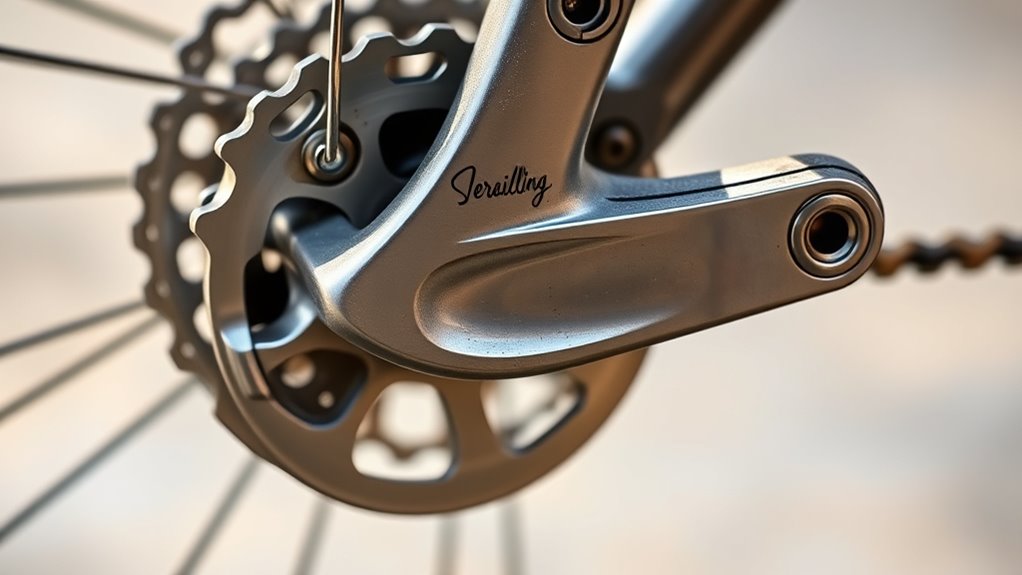
A derailleur that isn’t functioning properly will often reveal itself through noticeable shifting issues. You might experience gear skipping, where the chain suddenly jumps over a gear, or hear persistent chain noise even when pedaling smoothly. These signs indicate something’s off.
- You hear inconsistent or loud chain noise during rides, signaling misalignment or worn components.
- Your gears don’t change smoothly, causing hesitation or sticking.
- The chain skips or jumps under load, making riding unpredictable and frustrating.
Ignoring these signs can lead to further damage and poor performance. If you notice any of these issues, it’s time to inspect your derailleur and perform necessary adjustments.
Addressing these problems early keeps your bike shifting smoothly and ensures a safe, enjoyable ride.
Step-by-Step Guide to Adjusting Your Derailleur
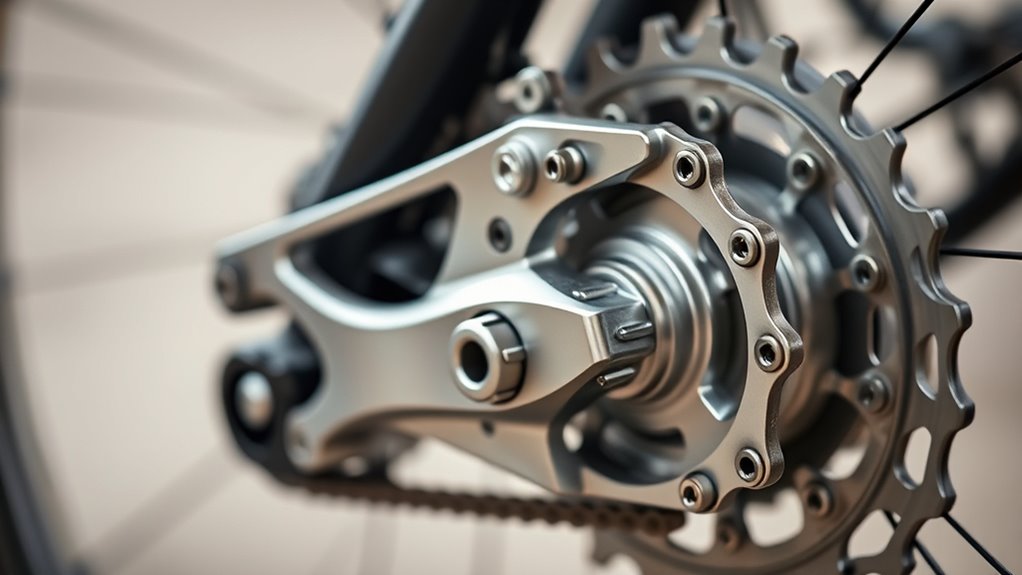
When you notice shifting problems like gear skipping or hesitation, it’s time to modify your derailleur. Proper adjustment guarantees smooth transitions, respecting derailleur etiquette and maintaining ideal gear ratio. Start by shifting to the smallest sprocket. Use a Phillips or flat-head screwdriver to turn the barrel adjuster—clockwise to tighten, counterclockwise to loosen. Check the cable tension; it controls how the derailleur moves across gears. Use the table below to fine-tune your derailleur:
| Step | Action | Result |
|---|---|---|
| Shift to smallest sprocket | Ensure derailleur aligns with the smallest gear | Accurate starting point |
| Adjust barrel adjuster | Fine-tune cable tension | Better gear shifting |
| Check alignment | Confirm derailleur hanger is straight | Prevents mis-shifts |
| Test shifting | Shift through all gears, observe smoothness | Seamless gear changes |
| Final check | Ensure derailleur is properly positioned after adjustment | Ideal gear ratio and etiquette |
Follow these steps for precise, reliable shifting.
Tips for Maintaining Optimal Gear Performance

To keep your bike’s gears performing at their best, regular maintenance is essential. Focus on gear lubrication to guarantee smooth shifting and prevent rust. Make derailleur cleaning a priority—removing dirt and debris keeps components moving freely and extends their lifespan. Properly lubricated and clean derailleurs reduce cable friction, making gear shifts crisp and reliable.
Regular gear lubrication and derailleur cleaning ensure smooth, reliable shifting and extend component lifespan.
Here are some tips to maintain ideal gear performance:
- Regularly apply gear lubrication to moving parts to prevent squeaks and ensure smooth operation
- Clean your derailleur weekly to remove grime that hampers shifting
- Check and tighten cable tension to keep shifts precise and responsive
Consistent maintenance keeps your ride smooth, safe, and enjoyable. Don’t neglect these simple steps—they make all the difference in gear performance.
Frequently Asked Questions
How Often Should I Lubricate My Derailleur?
You should lubricate your derailleur regularly to maintain smooth shifting and extend its lifespan. A good lubrication schedule is every few rides or when you notice stiffness or noise.
Proper lubrication prevents rust and reduces wear, helping your derailleur function efficiently longer. Keep an eye on it, and don’t wait too long between applications—consistent lubrication is key to maximizing its performance and prolonging its overall lifespan.
Can I Upgrade My Derailleur for Better Performance?
Oh, sure, upgrading your derailleur sounds like a brilliant idea—until you realize it’s all about gear compatibility and material durability.
You’ll need to match new parts perfectly and guarantee they withstand your riding style. A shiny new derailleur might look tempting, but if it’s not compatible or durable enough, you’ll just be throwing money into the wind.
What Tools Are Needed for Derailleur Adjustment?
For derailleur adjustment, you’ll need a tools checklist that includes a Phillips or flat-head screwdriver, Allen wrenches, and a bike-specific derailleur hanger alignment tool.
These tools help you perform precise adjustment techniques like tuning the limit screws and indexing.
With the right tools, you can easily tweak your derailleur for smooth shifting, ensuring your bike performs at its best.
Always double-check your adjustments and test ride afterward.
How Do Weather Conditions Affect Derailleur Performance?
Weather conditions definitely impact derailleur performance. Rain impact can cause dirt and grime to build up, leading to sluggish shifting or chain slipping.
Temperature effects also matter; cold weather can stiffen cables, making shifts less responsive, while heat can cause components to expand slightly.
You should regularly clean and lubricate your drivetrain, especially in wet or extreme temperatures, to keep your derailleur functioning smoothly and avoid costly repairs.
Is It Necessary to Replace the Entire Derailleur When It Malfunctions?
When your derailleur malfunctions, you might wonder if replacing the entire unit is necessary. Often, it’s not; many issues stem from misalignment, dirty components, or worn-out parts that can be repaired or adjusted.
The derailleur lifespan varies, but if it’s severely damaged or repeatedly problematic, replacement becomes necessary. Usually, a thorough inspection helps determine if a repair suffices or if a full replacement is the best choice.
Conclusion
Now that you know how derailleurs work and how to adjust them, you’re better equipped to keep your bike shifting smoothly. Regular maintenance prevents small issues from turning into big headaches, saving you time and money. Remember, a well-tuned derailleur is the backbone of a smooth ride—don’t let things spiral out of control. Keep your gears in check, and you’ll stay ahead of the curve, ready to hit the road with confidence.
